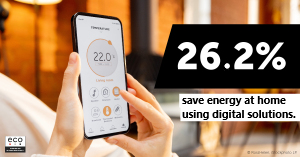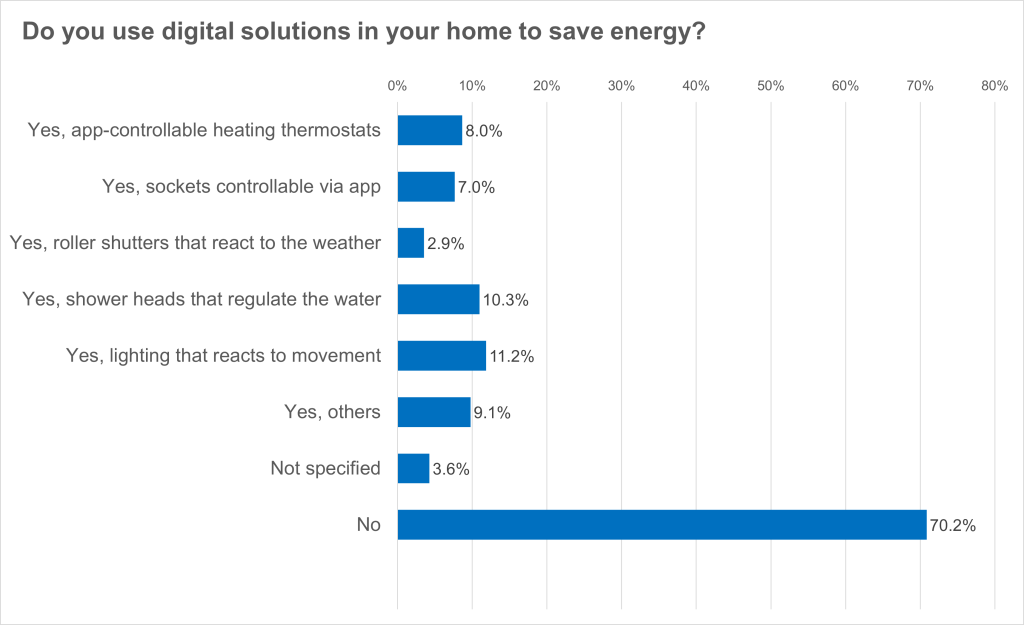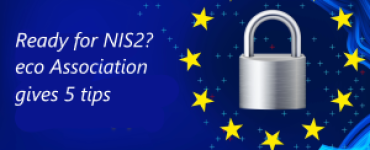- eco survey on the start of the heating season
- 8.2 per cent of Germans use app-controllable heating thermostats
- eco Association gives 6 security tips for smart home devices
At the beginning of the 2023 heating season, only 8 per cent of Germans use smart heating thermostats that can be controlled via an app. Just a few take advantage of other digital solutions to save energy: 11.2 per cent of Germans control their lighting using motion detectors, while 10.3 per cent use smart shower heads. Additionally, only 7 per cent control their sockets via an app. Overall, only one in four Germans (26.2 per cent) use digital solutions to save energy. These findings are the results of a representative survey of 2,512 people conducted by the opinion research institute Civey on behalf of eco – Association of the Internet Industry.
“Digital technologies at home save energy and counteract rising energy costs,” says Markus Schaffrin, Head of Member Services at the eco Association. “Many people are not aware of how easy it is to reduce carbon emissions using digital solutions.” For example, smart heating thermostats make it possible to heat rooms as needed. “You can precisely set the thermostats using a heating plan, control them via a mobile app while on the go or operate them by voice commands. It is also possible to integrate these devices into the smart home system. Some models also regulate the temperature entirely according to our preferences and behaviour,” Schaffrin goes on to say. In conjunction with window sensors, smart home systems can detect whether heating energy is being wasted. Smart shower heads provide immediate feedback on energy and water consumption and, therefore, motivate people to save energy.
IT security is essential when commissioning smart home solutions that are networked via the Internet. Markus Schaffrin gives 6 tips for a secure smart home:
- Only connect potentially insecure devices to the base station: Older devices typically lack updates and may not have security certificates. Special caution should be exercised with devices that process sensitive data, such as smart door locks and surveillance cameras. If possible, such devices should only be connected to their base station (gateway), which takes over control tasks, rather than being directly connected to the Internet.
- Change default passwords: The default passwords of many smart home devices can be easily researched on the Internet and are commonly exploited by cybercriminals. Therefore, it is crucial to change these default passwords immediately. A risk remains if devices have a manufacturer-set maintenance access password.
- Pay attention to security certificates: Consumers minimise their risks if they pay attention to security certificates such as the “IT Security Label” from the German Federal Office for Information Security (BSI). This label enables “real-time monitoring” by means of a QR code on the device, allowing users to check daily for vulnerabilities and available security updates.
- Use separate networks for smart home devices and sensitive data: If you operate an extensive smart home with many devices, it is worthwhile to set up a separate network for these devices. This minimises the risk of attackers using insecure smart home devices to access sensitive data on the user’s computer, tablet or mobile phone. It also allows for better control over the flow of data within this network in order to detect unauthorised If the smart home devices are supposed to be turned off, but there is still a significant amount of network traffic, it is possible that the coffee machine, for example, could be exploited by someone else who is using it for cyberattacks such as DDoS attacks.
- Keep devices up to date: Users should regularly stay informed about updates and install them. For this purpose, it can be helpful to create a list of all your devices and check for updates at certain intervals.
- Use all available security mechanisms: If devices offer additional security mechanisms, such as two-factor authentication, users should also use these.
Download graphic
Download Markus Schaffrin’s photo
Download press photo





